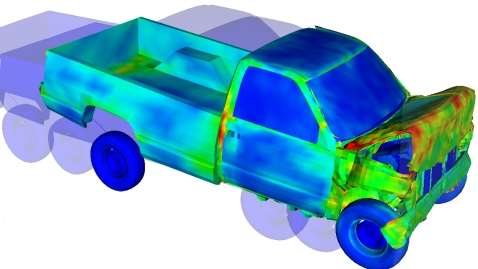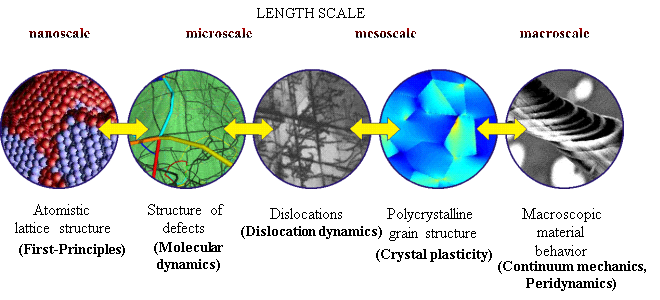The idea of describing a physical phenomenon using mathematical models/computational tools is not a new one. About 430 years ago, Galileo Galilei exhorted that it is imperative to describe the results mathematically once a certain number of experiments “sensate esperienze” have been performed. If one succeeds in illustrating the physical phenomenon using the mathematical equations, then the response of the system of interest can be predicted for a broad range of conditions, including the ones for which conducting the experiments are very difficult, too costly, or not possible at all. In the recent years, the use of computational studies in materials research has been fueled by the drastic increase in the available computational power, resulting from the development of advanced computers with parallel architecture tuned for computationally intensive tasks.
Nowadays, the leading engineering companies, such as GM, Ford, GE, Airbus and Boeing use computer simulations to model and test mechanical and aerodynamic characteristics of their products such as automobiles, jet engines and aircrafts before manufacturing the final product or even before testing a prototype in a wind tunnel or crashing them into a wall e.g. Figure 1. shows the deformed shape of the body of a truck body after it is crashed into a rigid wall simulated using a software. Among the numerous benefits of the simulation/computational tools in materials research, one is that if any problems are found in the design during modeling, it can be fixed before sending the technical drawings to the manufacturing unit of the company.

Figure 1. 3D simulation of a truck crashing into a rigid virtual wall[1]
Now, if we are going to predict the material behavior using the software/computational tools, then the accuracy of the software comes into limelight. The accuracy of these predictions depends on:
1. The accuracy of the adopted numerical solvers (e.g. a very popular scheme known as FEM),
2. The accuracy of the mathematical models that describe the material’s behavior (i.e. constitutive laws).
In addition to above, different mechanisms occur at different length scales that govern the macro behavior of the material. Therefore, in order to improve the accuracy of predictions of the software, information of these mechanisms happening at different length scales is also required, which lays down the need for a multi-scale model. In science and engineering, nearly all problems are multi-scale in nature. For example, multi-scale modeling of cancer cells is now being considered as an indispensable tool to enable more accurate predictions of growth of cancer cells (reference). Now, in context of modeling behavior of metals, different mathematical models that describe the physics of deformation at different length scales are used and are shown in Figure 2.

Figure 2. Overview of length scales involved in metals[2]
At atomic scale, the interaction forces between neighboring atoms are calculated using the First-Principles Density Functional Theory (DFT) but the computations are limited to a few hundred atoms, which is too small to study the macro behavior of a material. To model the mechanical behavior of a material using molecular statics / dynamics several million atoms must be considered that involves days / weeks of computations. (Reference)Moreover, characteristic length that is accessible using molecular statics / dynamics modeling is very small than the mean free path of the motion of dislocations (defects in regular atomic lattice). Dislocations are the critical elements in a microstructure of a polycrystalline solid to accommodate the plastic deformation and to analyze the behavior of a material at a length scale, where the material hardening is controlled by the interactions of dislocation, discrete dislocation framework is used. However, due to the large amount of degree of freedoms required to analyze interactions of dislocations, the discrete dislocation framework is limited to model a material with volume up to 10 microns. Continuum mechanics / Peridynamics employ the phenomenological laws of motion and of deformation energy to describe the mechanical behavior of a material at macroscopic length scale neglecting any phenomena that occur at smaller length scales which leads to a deficiency in the accuracy of the predictions.
Nevertheless, there exists a framework at an intermediate scale (meso-scale) that models dislocations behavior in terms of slip and considers some vital microstructural features providing a very close estimate of real-word phenomena within reasonable computational time, known as crystal plasticity. Crystal plasticity-based models work at a length scale where the groups of crystals i.e. grain in a material becomes evident. In crystal plasticity models, usually a representative volume element (RVE) of the actual component is analyzed that yields a value which represents the behavior of the whole material. Hence, using crystal plasticity alone, one cannot simulate the actual lab scale (at macro-scale) component. Therefore, in order to accurately describe, to fundamentally understand, to reliably predict, and to eventually control the behavior of a material under different conditions, it is of tremendous importance to develop novel approaches that investigate the multiscale nature of metals.
In this research work, a new multi-scale framework is proposed that incorporates physics of fine scale phenomena using crystal plasticity-based modeling approach with a Peridynamics-based coarse scale modeling approach. In addition, an attempt is made to enhance their existing modeling capabilities both in term of accuracy as well as computational speed with an interest to study effects of microstructure on:
[1] http://www.mscsoftware.com/product/dytran
[2] http://www.kochmann.caltech.edu/pics/scales0.gif
You have to be 100% sure of the quality of your product to give a money-back guarantee. This describes us perfectly. Make sure that this guarantee is totally transparent.
Read moreEach paper is composed from scratch, according to your instructions. It is then checked by our plagiarism-detection software. There is no gap where plagiarism could squeeze in.
Read moreThanks to our free revisions, there is no way for you to be unsatisfied. We will work on your paper until you are completely happy with the result.
Read moreYour email is safe, as we store it according to international data protection rules. Your bank details are secure, as we use only reliable payment systems.
Read moreBy sending us your money, you buy the service we provide. Check out our terms and conditions if you prefer business talks to be laid out in official language.
Read more